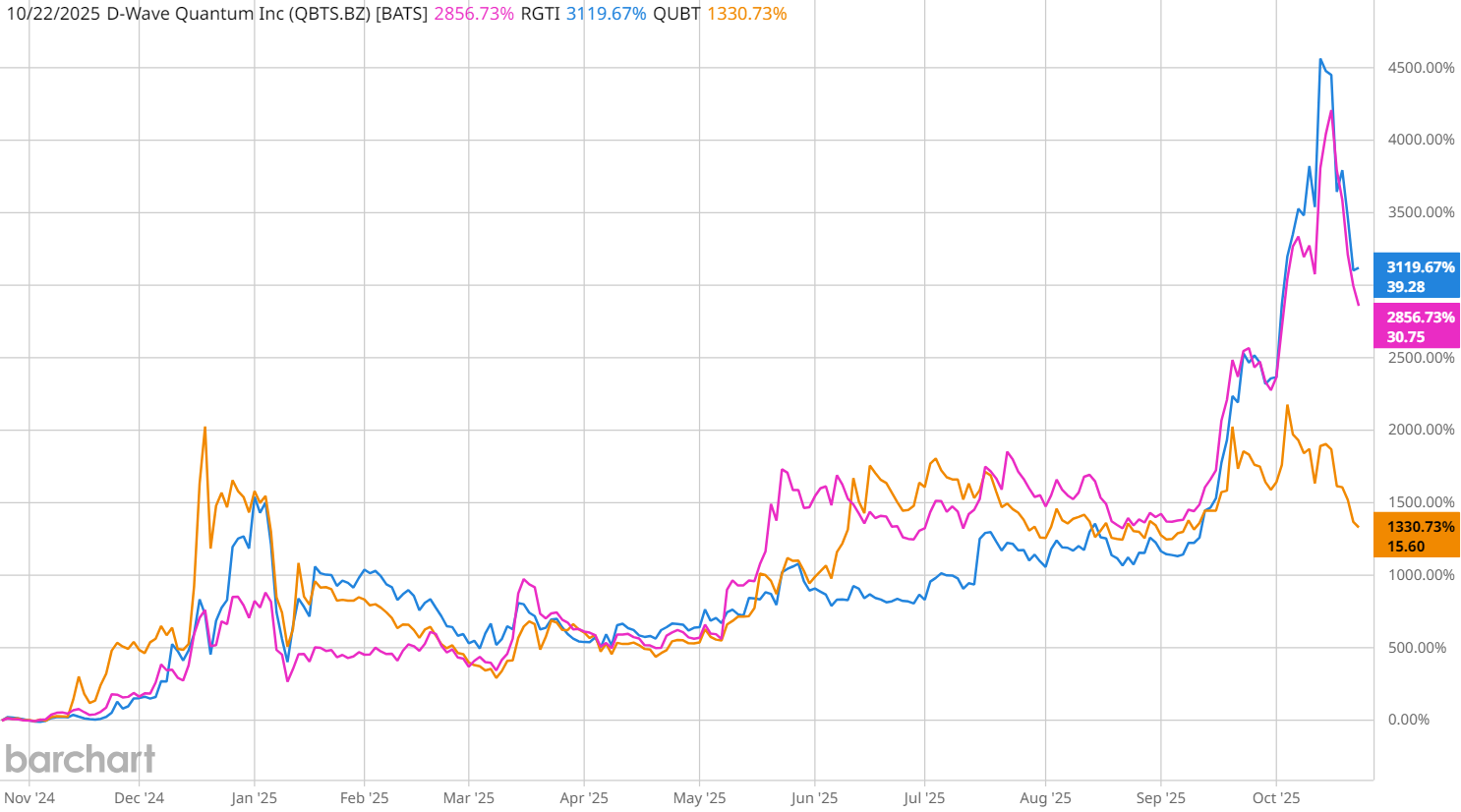Are Quantum Stocks a Bursting Bubble? Here’s What Our Top Chart Strategist is Watching Now
Barchart Insights - Barchart - Wed Oct 22, 9:33AM CDT Columnist
Share
/Quantum%20Computing/Image%20by%20Funtap%20via%20Shutterstock.jpg)
Image by Funtap via Shutterstock
When 74% of traders on X say they believe quantum computing stocks are in a bubble… it’s probably worth paying attention.
That was the question Twitter Tom posed during our latest Market on Close livestream — and when Senior Market Strategist John Rowland pulled up the data, his verdict was clear:
“Yeah, I think this is definitely a bubble.”
Let’s unpack why John says so — and which other corners of the market may be showing the same warning signs.
The Quantum Boom – and Burn RateQuantum computing stocks have exploded in 2024–2025, with names like IonQ (IONQ), Rigetti Computing (RGTI), and Quantum Computing (QUBT) leading the pack.
John sorted Barchart’s Quantum Computing Stocks watchlist by 52-week percentage gains — and the numbers were jaw-dropping:
Some are up 1,000% to over 3,000% in just a year.
 www.barchart.com www.barchart.com
But do the fundamentals match those multibagger returns?
- IonQ made roughly $50 million in revenue last year but lost $170 million.
- Rigetti pulled in about $11 million, losing over $200 million.
- D-Wave Quantum (QBTS) raked in $22 million, while losing $167 million.
“These are companies with massive cash burn,” John notes, “and their products — or scalable profitability — might still be a decade away.”
That’s a recipe for volatility. After a 16% spike on Monday, Oct. 13, IonQ has dropped roughly 27% from those highs in the ensuing sessions.
“That kind of price action,” John notes, “is bubblicious.”
It’s Not Just QuantumJohn pointed out that this speculative euphoria isn’t isolated. He’s seeing it ripple through other “next-gen” sectors — like rare earth metals, drone stocks, and battery tech microsectors.
Take Lithium Americas (LAC), a company he personally owns. After back-to-back gains of 12% and 19%, it gave nearly all of it back within three trading sessions.
“It’s not just quantum,” John says. “It’s rare earths, it’s batteries, Wi-Fi, drones… the list goes on.”
The pattern is the same: huge spikes, then rapid reversals.
The Pattern: Microsectors, Macro SpeculationThis isn’t the first time we’ve seen a “micro-bubble” cycle like this. From electric vehicles (EVs) in 2021 to artificial intelligence (AI) in 2023, speculative pockets of the market tend to inflate quickly when liquidity is strong and narratives are hot.
What’s unique now is how many of these themes are overlapping:
- AI infrastructure needs rare earths, lithium, and quantum hardware.
- Governments are funding next-gen tech at record levels.
- Retail investors are chasing the same small-cap names.
That convergence creates “supercycles” — but also super-risk.
What Traders Can Do NowIf you’re trading or investing in these names, there are steps you can take to stay ahead of a bursting bubble:
- Acknowledge the volatility. These stocks can swing 10–20% in a day, so don’t get complacent.
- Use the Trader’s Cheat Sheet. Set alerts around key support and resistance .
- Diversify your exposure. Don’t concentrate your portfolio in just one hype theme; diversify with an ETF.
- Watch for mean reversion. When prices spike far from moving averages, reversals often follow.
Explore these tools to stay ahead of the moves:
The TakeawayQuantum computing might power the future — but right now, it’s showing all the signs of a speculative frenzy.
“When you’ve got 2,000% to 4,000% moves in companies losing hundreds of millions,” John says, “that’s not a steady bull market — that’s a bubble.”
Whether it’s quantum, rare earths, or battery storage, traders should stay alert. Volatility cuts both ways — and timing will matter more than ever.
Watch the Clip: Are Quantum Stocks in a Bubble? |





/Quantum%20Computing/Image%20by%20Funtap%20via%20Shutterstock.jpg)
